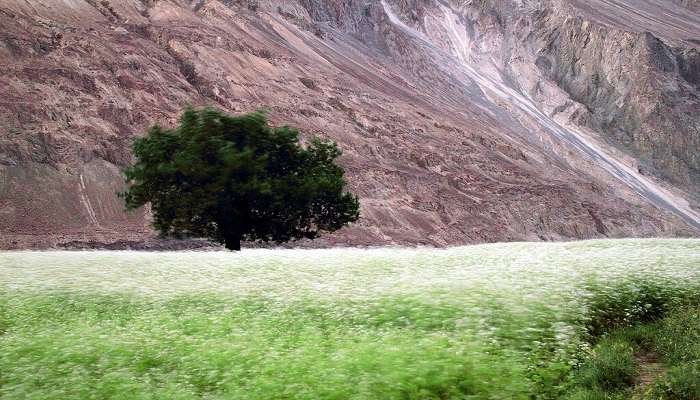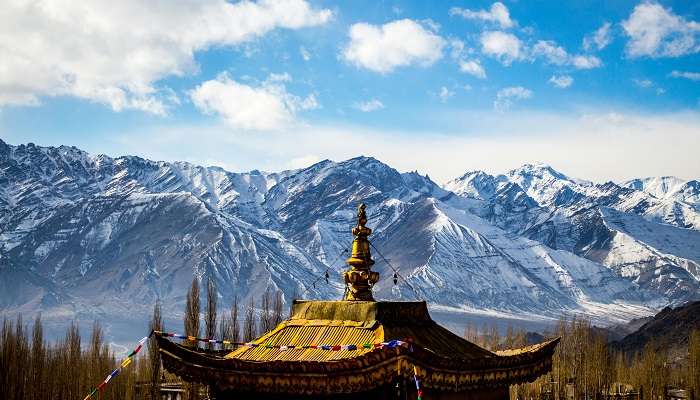Visit Turtuk Village In Ladakh A Journey To Hidden Paradise Of 2025

Nestled in the scenic Shyok Valley, Turtuk Village in Ladakh is a must-visit destination with breathtaking views and a rich historical tapestry. Situated in the Nubra Valley near the India-Pakistan border, Turtuk is one location that will take your breath away. It is particularly unique as it is the youngest region in the Union Territory. When visiting this picturesque location, you’ll first notice the charming landscape stretching expansively. Encompassed with a rich culture and a serene environment, Turtuk provides a tranquil escape from the busy life and daily stress. Visitors can enjoy hiking and local cuisine and immerse themselves in traditional Balti culture.
Exploring Turtuk Village In Ladakh
If you are planning to visit the valleys of Turtuk, this village offers a variety of activities and sites that will elevate your unforgettable trip.
1. Going Around Turtuk

Turtuk offers numerous trails and a scenic journey through magnificent landscapes where you traverse lush green fields and visit ancient monasteries. The village’s remote location adds to its charm, and trekking here will allow you to meet the friendly locals and experience their unique Balti culture. The trails open up to expansive views of the Karakoram Range, with orange-hued apricot orchards and wheat fields dotting the scenery.
If you drive a short distance from Turtuk Village,you will reach the Hunder Sand Dunes, which offers a unique and mesmerising landscape amidst the stark beauty of the Nubra Valley. This desert area, known for its white sand dunes, contrasts sharply with the green landscape of Turtuk. Visitors can also enjoy fun camel safaris, which take them on the double-humped Bactrian camels that are native to this region.
Also Read: Places To Visit In Leh Ladakh
2. A Glimpse Into The Past

Turtuk has a rich history. The village was part of Pakistan until 1971, and hence, it retains a unique cultural blend of Ladakhi and Balti influences. Previously known as the Baltistan region, Turtuk is located in the Karakoram range and is one of only four Indian villages. Travelling through the village, with its ancient mosques, monasteries, and royal houses, will tell the story of Turtuk’s past. Historically speaking, Turtuk was also an essential element of the Silk Route.
One of the notable sites is the Turtuk Palace, the residence of the Yabgo dynasty rulers. This historical site provides a glimpse into the village’s regal heritage and strategic importance over the centuries. Turtuk has stayed isolated for a long time due to its challenging geography and recent political issues. This significance is reflected in its rich cultural heritage, showcasing its unique blend of influences and traditions.
3. Flora In Turtuk

Turtuk is an oasis of lush fruit orchards, vast meadows of wildflowers, and fields of buckwheat, which are a few names that are deeply within the flora of this valley. Agriculture is vital to the economy, and many families rely on farming for their livelihood. The fertile soil and favourable climate conditions allow for the cultivation of various crops, including barley, wheat, vegetables and shrubbery like Juniper. The presence of fruit orchards such as apples and walnuts supports local agribusiness, with produce often sold in nearby markets.
Flora in Turtuk is deeply intertwined with the cultural and spiritual practices of the local people. Many plants and trees are considered sacred and are used in traditional ceremonies and rituals. The apricot, for instance, is not only a source of nutrition but also holds cultural significance, with various parts of the plant being used in local crafts and medicine.
Related Post: Things To Do In Ladakh
4. Wildlife In Turtuk

Turtuk Village in Ladakh, India, is an enthusiast’s paradise, offering a glimpse into the diverse ecosystem of the Himalayas. Visitors can occasionally spot elusive snow leopards prowling the rugged terrain, the Himalayan ibex scaling steep cliffs, and, if they are lucky, Tibetan wolves. Majestic golden eagles also soar high, while playful Marmots entertain on the meadows. The region is also home to various birds of prey like the Lammergeier and Himalayan Griffon Vulture.
The flora of Turtuk, including alpine meadows and juniper forests, provides a vital habitat for its wildlife. From the Snow Leopard to the charming Marmot, Turtuk’s wildlife showcases the delicate balance of nature in this remote landscape. A visit to Turtuk Village promises an unforgettable wildlife experience, where every sighting and encounter leaves a lasting impression of the natural world.
5. Cultural Immersion

One of the highlights of visiting Turtuk is immersing yourself in the local Balti culture. The villagers are known for their warm hospitality and vibrant traditions. If you see, you must participate in local festivals, learn about traditional farming practices, and taste the delicious Balti cuisine.
Also located about 40 kilometres from Turtuk is the Diskit Monastery, the oldest and largest Buddhist monastery in the Nubra Valley. Perched atop a hill, it offers panoramic views of the valley below and is known for its 32-metre-tall statue of Maitreya Buddha overlooking the Shyok River. One of the highlights is the annual Dosmoche festival, celebrated in winter. This festival features colourful mask dances the monks perform to ward off evil spirits and bring peace and prosperity to the region.
You May Also Like To Read: Secrets Of Ladakh
Turtuk Village in Ladakh, with its rich history and breathtaking landscapes, stands as a testament to the enduring spirit of its people. A visit to this hidden gem will give you a deeper appreciation for the beauty and resilience in the heart of the Karakoram mountains. A trip to Ladakh is an opportunity to connect with the essence of what makes travel truly enriching—the people, the stories, and the stunning landscapes, so get ready to witness the magic of Ladakh and Turtuk.
For our editorial codes of conduct and copyright disclaimer, please click here.
Cover Image Credit: Rajnish71 for Wikimedia Commons
Frequently Asked Questions On Turtuk Village In Ladakh
What is the best time to visit Turtuk Village?
The best time to visit Turtuk Village is from May to September. During these months, the weather is pleasant, and the landscape is lush and green, providing an ideal setting for sightseeing and outdoor activities. The winters, from October to April, can be freezing, with heavy snowfall often cutting off access to the village.
How do I reach Turtuk Village?
Turtuk Village is located in the Nubra Valley, about 200 kilometres from Leh, the capital of Ladakh. The most common way to reach Turtuk is by road via the Khardung La Pass, one of the highest motorable roads in the world. Buses and taxis are available from Leh, and the journey offers spectacular views of the Himalayan landscape.
What are the main attractions in Turtuk Village?
Turtuk Village is known for its stunning natural beauty, traditional Balti culture, and historical significance. The picturesque landscapes, apricot orchards, and the Turtuk Monastery are key attractions. Visitors can also explore the ancient mosques and royal houses. The village's proximity to the Line of Control adds a unique historical and geopolitical interest.
Are there accommodations available in Turtuk Village?
Yes, Turtuk Village offers various accommodation options, including guesthouses, homestays, and small hotels. Staying in a homestay is a popular choice as it provides an opportunity to experience local Balti culture and hospitality firsthand. It is advisable to book your stay in advance, especially during peak tourist season, to ensure availability.
What should I carry when visiting Turtuk Village?
It’s important to carry warm clothing, even in summer, as temperatures can drop significantly at night. Other essentials include comfortable walking shoes, sunscreen, a hat, and a reusable water bottle. Additional gear like trekking poles and a backpack will be useful if you plan on trekking. Don’t forget a camera to capture the breathtaking scenery.
Are there any cultural practices I should be aware of in Turtuk Village?
Yes, Turtuk Village has a predominantly Balti Muslim population. Hence, it’s important to respect local customs and traditions. Dress modestly, particularly when visiting religious sites. Engaging with locals respectfully and observing their practices will enhance your experience. It’s also customary to ask for permission before photographing people or their homes.
People Also Read:
Sari Village Pathauli Village Ghangaria Village

Unveil the hidden treasures of the globe and turn every travel dream into reality. As a Content Writer, I am passionate enough to craft stories from ancient wonders to modern marvels. My words paint the picture-perfect itinerary for unforgettable experiences. Let my words be your trusted guide to immerse in the diverse culture and discover the beauty of the unknown.











